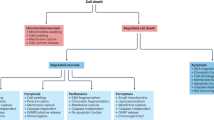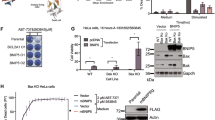Abstract
DYSREGULATION of apoptosis can result in inappropriate suppression of cell death, as occurs in the development of some cancers1, or in failure to control the extent of cell death, as is believed to occur in acquired immunodeficiency and certain neurodegenera-tive disorders, such as spinal muscular atrophy (SMA). Recently, we isolated a candidate gene, encoding neuronal apoptosis inhibitor protein (NAIP)2, for SMA. This gene is homologous to two baculovirus inhibitor of apoptosis proteins3,4(Cp-IAP and Op-IAP) and is partly deleted in individuals with type I SMA. A second SMA candidate gene encoding survival motor neuron (SMN), which is contiguous with the NAIP locus on 5ql3.1, was also reported5. Here we demonstrate a NAIP-mediated inhibition of apoptosis induced by a variety of signals, and have identified three additional human complementary DNAs and a Drosophila melanogaster sequence that are also homologous to the baculovirus lAPs. The four open reading frames (ORFs) possess three baculoviral inhibition of apoptosis protein repeat (BIR) domains and a carboxy-terminal RING zinc-finger. The human iap genes have a distinct but overlapping pattern of expression in fetal and adult tissues. These proteins significantly increase the number of known apoptotic suppressors.
This is a preview of subscription content, access via your institution
Access options
Subscribe to this journal
Receive 51 print issues and online access
$199.00 per year
only $3.90 per issue
Buy this article
- Purchase on SpringerLink
- Instant access to full article PDF
Prices may be subject to local taxes which are calculated during checkout
Similar content being viewed by others
References
Thompson, C. B. Science 267, 1456–1462 (1995).
Roy, N. et al. Cell 80, 167–178 (1995).
Crook, N. E. Clem, R. J. & Miller, L. K. J. Virol. 67, 2168–2174 (1993).
Clem, R. J. & Miller, L. K. Molec. cell. Biol. 14, 5212–5222 (1994).
Lefebvre, S. et al. Cell 80, 155–165.
Thor, H. et al. J. biol. Chem. 257, 12419–12425 (1982).
Altschul, S. F., Gish, W., Miller, W., Myere, E. W. & Lipman, D. J. J. J. molec. Biol. 215, 403–1 (1990).
Vaux, D. L., Haecker, G. & Strasser, A. Cell 76, 777–779 (1994).
Martin, S. J. & Green, D. R. Cell 82, 349–352 (1995).
Steller, H. Science 267, 1445–1449 (1995).
Fujita, A., Sakagami, K., Kanegae, Y., Saito, I. & Kobayashi, I. J. Virol. 69, 6180–6190 (1995).
Rosenfeld, M. A. et al. Cell 68, 143–155 (1992).
Graham, F. L. & Van Der Eb, A. Virology 52, 456–467 (1973).
Rotman, B. Proc. natn. Acad. Sci. U.S.A. 47, 1981–1991 (1961).
Egan, S. E. et al. Nature 363, 45–51 (1993).
Author information
Authors and Affiliations
Rights and permissions
About this article
Cite this article
Listen, P., Roy, N., Tamai, K. et al. Suppression of apoptosis in mammalian cells by NAIP and a related family of IAP genes. Nature 379, 349–353 (1996). https://doi.org/10.1038/379349a0
Received:
Accepted:
Issue Date:
DOI: https://doi.org/10.1038/379349a0



